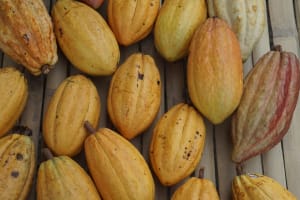Did you know white chocolate is not really chocolate, chocolate was once used as a currency, and Benjamin Franklin sold chocolate in his print shop? These are just some of the quirky facts surrounding chocolate. Today, we are focusing on the chic OU kosher-certified company that produces kosher chocolate bars, “HU,” short for human, that offers a variety of unique flavor combinations that can be enjoyed for all occasions. For Shavuot, where there is a custom to eat dairy, we have also included a chocolate cheesecake recipe.
History of Chocolate
There is a rich history to chocolate that dates back many millennia. Chocolate has its roots in Mesoamerica (Meso, meaning middle, a term coined by anthropologist Paul Kirchoff in 1943) with some saying it can even be traced back to the Amazon. Mesoamerica is located in what today would be Southern Mexico and Central America. It saw the rise of the Olmecs, Maya and Aztec civilizations from approximately 1500 BCE to 1520 CE.
The Olmecs were the first to discover and incorporate chocolate into their society starting in approximately 1500 BCE. In regard to the Olmecs, Hayes Lavis, a curator at the Smithsonian says, “There is no written history for the Olmecs, but pots and vessels uncovered from this ancient civilization show traces of the cacao chemical theobromine.” The Mayans continued to harvest chocolate where it became a major part of their society, including being used as currency and serving as drinks at spiritual ceremonies. They referred to the cocoa tree as Theobroma cacao to mean “food of the gods.” The Aztecs coined the phrase “xocoatl,” the origin of the word chocolate. Chocolate continued to play a crucial role in Aztec society. After the Spanish conquest of Mesoamerica in the 16th century, chocolate was exported to Europe where it became available to the masses.
In early America, most of the cocoa beans and sugar were imported through the Philadelphia ports. Eventually, sugar refineries were built and chocolate made its way across America. Today it’s a staple food in the United States and is consumed by millions. Presently, the chocolate market is a multibillion-dollar industry. Certain topographical areas currently stand out as cocoa producers and exporters. The Ivory Coast, located on the southern coast of West Africa, is the largest producer of cocoa. It’s a large driving force for the resilience of their economy. Ghana, Indonesia and Nigeria are the next largest producers.
Cocoa Beans and Production
Most cocoa beans, the primary ingredient in chocolate, are harvested from pods and come in three varieties: Criollo, Forastero and Trinitario. Forastero is the most commonly harvested. It became the choicest variety on account of its pleasant scent and durability. Criollo is the highest quality, but the most expensive. It’s grown more scarcely and is more vulnerable to disease. Trinitario is a hybrid of Criollo and Forastero cocoa taking strengths and weaknesses from both.
A specific production method exists that turns the cocoa beans into chocolate and therefore kashrut sensitivities need to be monitored closely. The initial step towards chocolate production mimics the same practices employed centuries ago. The pods, which encase the cocoa beans, are removed from the trees. The beans are then removed from the pods and fermented. Then the roasting takes place. This is followed by a process of winnowing where the cocoa beans are cracked, and the outer shells are removed. The cocoa beans are then broken into small pieces. These small pieces are ground in a machine to form a paste called cocoa liquor or cocoa paste. Then cocoa butter, sugar and milk are mixed in. The mixture stays until it’s hardened. Then it’s refined by going through cylinders that even out the cocoa butter and the mixture. Tempering is the last step to smooth out the chocolate. It is then sent out to manufacturers who create the final product. White chocolate, however, is not chocolate as it’s based in cocoa butter, vanilla and sugar.
Kashrut Sensitivities
Certain ingredients that are put in the mixture of chocolate must be monitored. Lecithin (a soy derivative) can contain animal-based fatty acids. Whey, fat-based emulsifiers and butter oil must also be monitored from the source. If the company only produces dairy, then there would be no issues relating to the equipment. On the other hand, if the company also produces pareve chocolate, then kashering the equipment becomes more complex because companies are reluctant to use boiling water as water can damage the chocolate. This issue can be addressed in many ways. Sometimes, the conche (the tank where the chocolate is prepared) can be kashered with torches. If this is not possible, depending on why there is a need to kasher and other factors, the OU may allow for kashering with very hot vegetable oil (such as soybean oil) in place of water. Pipes and other narrow areas likewise can be kashered with oil, or these areas can be purged, and then the pareve production will take place at below yad soledes bo. There also must be vigilance that the chocolate is not processed on equipment used for non-kosher products.
Chocolate and health
Healthwise, chocolate can provide a significant boost to the mood with serotonin qualities. Chocolate contains tryptophan, which the brain uses to produce serotonin, a chemical that is influential in regulating mood. The New York Times reported that based on a study, “People who regularly eat dark chocolate have a 70 percent reduced risk of depression.”
HU Chocolate
My wife is a lover of chocolate and we often discuss the day’s events over a bar of dark chocolate for dessert. We like to look and find new brands in order remain current. One brand we recently found was OU kosher-certified “HU” chocolate and these bars are pareve which brings a level of convenience. Its motto is “Get back to Human.” Their bars come in numerous flavors, including Crunchy Mint, Vanilla Crunch, Salty Dark Chocolate, Simple Dark Chocolate, Cashew Butter, Hazelnut Butter, Cashew Butter, and Almond Butter. They’re very conscientious about using healthy ingredients, including Fair Trade when available. The taste is very sophisticated!
Conclusion
According to Gourmet Healthy Chocolates, over “1 billion” people eat chocolate every day. It’s no surprise then, that according to The Fact Site the chocolate industry is worth approximately “$110 billion” per year. It’s projected by Business Wire that by the year 2025 it will be valued at “$182.090 billion.” Chocolate has a rich history and serves as an engine for global economic growth.
Chocolate Cheesecake recipe by Paula Shoyer Courtesy of Kosher.com:
Ingredients (8)
Crust
1 (8-ounce) package shortbread cookies or other vanilla cookies
4 tablespoons plus 1 tablespoon butter, divided
Filling
3 (8-ounce) packages cream cheese (not whipped)
4 large eggs
1 cup sugar
1/2 cup dark cocoa
1/2 teaspoon Gefen Pure Vanilla Extract
Garnish
1/2 cup whipping cream to decorate, if desired
Start Cooking
Prepare the Crust
Preheat oven to 325 degrees Fahrenheit.
- Place the butter into a microwave-safe bowl and heat for 30 seconds, or until melted.
- You will need a nine- or 10-inch springform pan. Trace the bottom on Gefen Easy Baking Parchment Paper and cut out the circle. Cover the top of the pan bottom with heavy duty aluminum foil, and then wrap the foil under the bottom. Attach the pan sides to the bottom, lock in place and then unwrap the foil and wrap up around the sides of the pan.
- Take the other tablespoon of butter and rub around the bottom and sides of the pan. Press the parchment circle in the bottom and grease the top. Set aside a large roasting pan with sides higher than two inches that can fit the springform pan inside.
- Place the cookies into the bowl of a food processor fitted with a metal blade and process until ground, but not completely in crumbs; leave some ¼-inch pieces. Add the melted butter and pulse a few seconds to mix. Spoon crumbs into the pan and press to cover the bottom of the pan. You can use a piece of waxed paper to help press the crumbs evenly while keeping your hands clean. Set aside.
Prepare the Filling
- Place the cream cheese into the bowl of a stand mixer or blender and whisk or mix until smooth.
- Add the eggs, one at a time, and scrape down the bowl each time to make sure all the cream cheese and eggs are being mixed together and the mixture looks creamy.
- Add the sugar and vanilla and mix well. Add the cocoa and mix well, making sure everything is mixed in.
- Pour the batter on top of the cookie crumbs in the pan.
Bake
- Place the springform pan inside the roasting pan and place on the middle rack of the oven. Bring over boiling water and pour into the roasting pan, around the cheesecake pan, until the water reaches one-third to halfway up the sides of the pan.
- Bake for one hour. Turn off the oven and then prop the oven door open with a wooden spoon. Leave the cake in the oven for 30 minutes. Remove the cake from the roasting pan and let cool on a rack until the cake is completely cooled.
- Place in the fridge for five hours or overnight. Serve with whipped cream if desired.
Note:
May be kept for four days in the fridge or frozen.





